by DGR Colorado Plateau | Dec 12, 2015 | Male Supremacy, Mining & Drilling
By teleSUR
Women from various Guatemalan communities struggling against resource extraction projects often face repression, criminalization, and violence. Mining projects and resource extraction in Guatemala exacerbate the discrimination and violence that women face in all areas of Guatemalan society, Rights Action Director Grahame Russell told teleSUR English Thursday.
“Repression and human rights violations caused by global mining operations in Guatemala have added negative effects on women in general and indigenous women in particular,” Russell told teleSUR English.
Russell’s comments come after human rights defenders slammed Guatemala’s widespread resource extraction on Wednesday for violating human rights, especially the rights of women, who often face attacks, sexual violence, and social and political repression for their work defending land and natural resources.

“Participants in the ‘We are Rights Defenders’ Forum.”
Women from various communities struggling against unwanted resource extraction projects throughout the country gathered in the capital Guatemala City to discuss the repression, criminalization, and violence disproportionately faced by women rights defenders, especially indigenous women, Prensa Latina reported.
Among the representatives were women from the community of La Puya, in central Guatemala, where they are key leaders in the blockade against the construction of a gold mine and central to the movement’s strategy of nonviolent resistance.
ANALYSIS: Facing Violence, Resistance Is Survival for Indigenous Women
The women called attention to the links between violence against women and the development model in Guatemala based on privatization, mining extraction, and exploitation of natural resources.
“When repression is committed by mining company security guards, soldiers, and police, rape and sexualized violence have also been used against women and girls,” said Russell. “When communities suffer health harm due to mining contaminated water sources, women and children suffer the consequences most.”
Forced displacement can also disproportionately impact women, Russell explained, as men sometimes accept low-paying mining jobs in exchange for their land behind the backs of women.
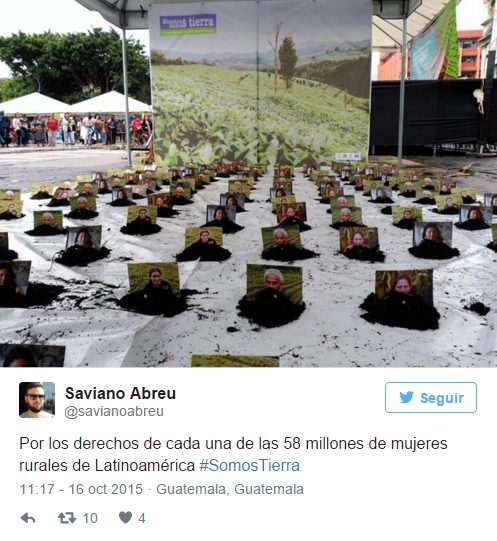
“For the rights of each one of the 58 million rural women in Latin America.”
According to women’s organizations present at the event, a femicide is committed in Guatemala every 10 hours, and one in every 10 women experience some form of gender violence. Guatemala, along with neighboring Central American countries El Salvador and Honduras, are among the worst countries in the world for gender violence and femicide.
Guatemalan activist, feminist artist, and politician Sandra Moran explained that women rights defenders regard women’s bodies, land, nature, history, and memory as all “territories in dispute,” Prensa Latina reported.
ANALYSIS: Femicide in Mesoamerica Persists as Systemic Gender Violence
According to Moran, violence against women “is a mechanism and effect of structural, patriarchal, capitalist system,” and this violence is used by the state to “control resistance, alternative proposals, and to maintain control over the bodies, sexualities, and lives of women,” she told teleSUR English earlier this year.
The activists’ message echoed the findings of a recent report by the Mesoamerican Initiative of Women Humans Rights Defenders, which found that women defending land and territory in the face of mining operations and other projects between 2012 and 2014 were the most vulnerable among all women rights defenders in Central America and Mexico to gender violence, including harassment, abuse, assassination attempts, and other attacks.
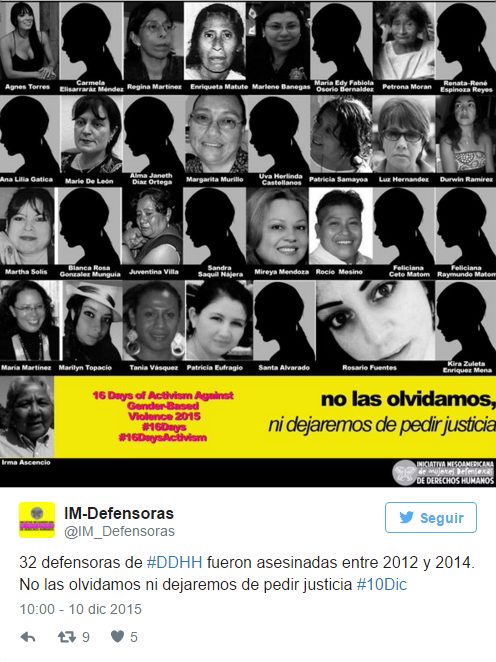
“Thirty-two women human rights defenders were murdered between 2012 and 2014. We do not forget them nor will we stop asking for justice.”
“It is extremely difficult to hold mining companies or government authorities, including police and soldiers, accountable — both in Guatemala and in Canada and the U.S. where most companies are based — when they carry out mining-related repression in general, let alone when it has doubly negative impacts on women and girls. Mining companies operating in Guatemala benefit from and contribute directly to the reigning impunity and corruption,” said Russell, referencing the precedent-setting case attempting to hold Canada’s Hudbay Minerals accountable in Canadian court for the rape of 11 indigenous women.
IN DEPTH: Women Resist
The call for more attention to be paid to the plight of women rights defenders comes ahead of the conclusion of the COP21 climate summit in Paris, where organizations and activists have slammed the draft deal for being weak on human rights protection and the recognition of indigenous communities in the context of climate change.
According to Global Witness, Guatemala is one of the 10 most dangerous countries in world for land and environmental defenders.
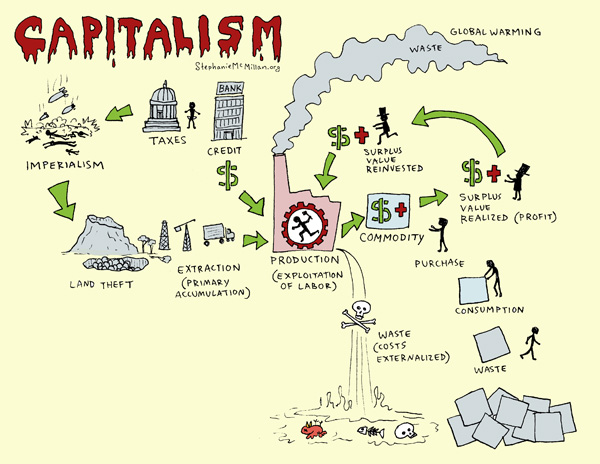
by DGR Colorado Plateau | Dec 10, 2015 | Colonialism & Conquest, Worker Exploitation
By One Struggle
“That country is poor.”
Translation: Your country had bountiful natural resources until we beat the hell out of you and stole everything.
“Their government is incompetent. They are unable to govern themselves.”
Translation: We invaded you, killed a bunch of you and set the rest at each other’s throats, and installed a dictator who’s helping us steal everything. But it’s your own fault that your country is a mess.
“The US helps people all over the world.”
Translation: If you don’t want our products or loans because they’ll ruin your economy, we’ll twist your arm until you take them. We’ll charge you for interest, inputs and maintenance far beyond the value of our original ‘assistance,’ and label ourselves saints and you ungrateful.
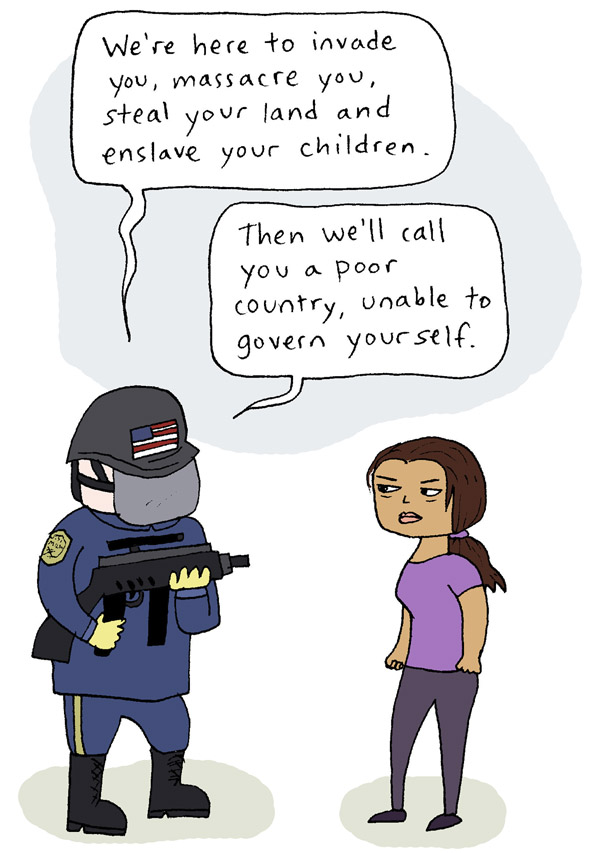
“Developing nations should be integrated into the global economy.”
Translation: First we’ll steal all your natural resources and destroy your economy, and then when your people are starving we’ll give them sweatshop jobs in our factories.
“We pay low wages but their living expenses are lower so it all works out.”
Translation: I’ll tell that lie to pacify domestic consumers, but really I don’t care if you starve.
“Okay, their lives are hard, but they should be grateful we gave them a job.”
Translation: You have no right to dignity, safety, to send your kids to school. I need that extra profit to pay for my fifth mansion in Switzerland.
“We are bringing democracy to the world.”
Translation: We’ll crush you.
“Without our help, they’d fall apart. They need us.”
Translation: We don’t produce anything, but we’re violent sociopaths loaded up with guns and nuclear weapons, so we’ll keep on sucking your blood as long as we can get away with it. If you ever stop us, we’ll die.
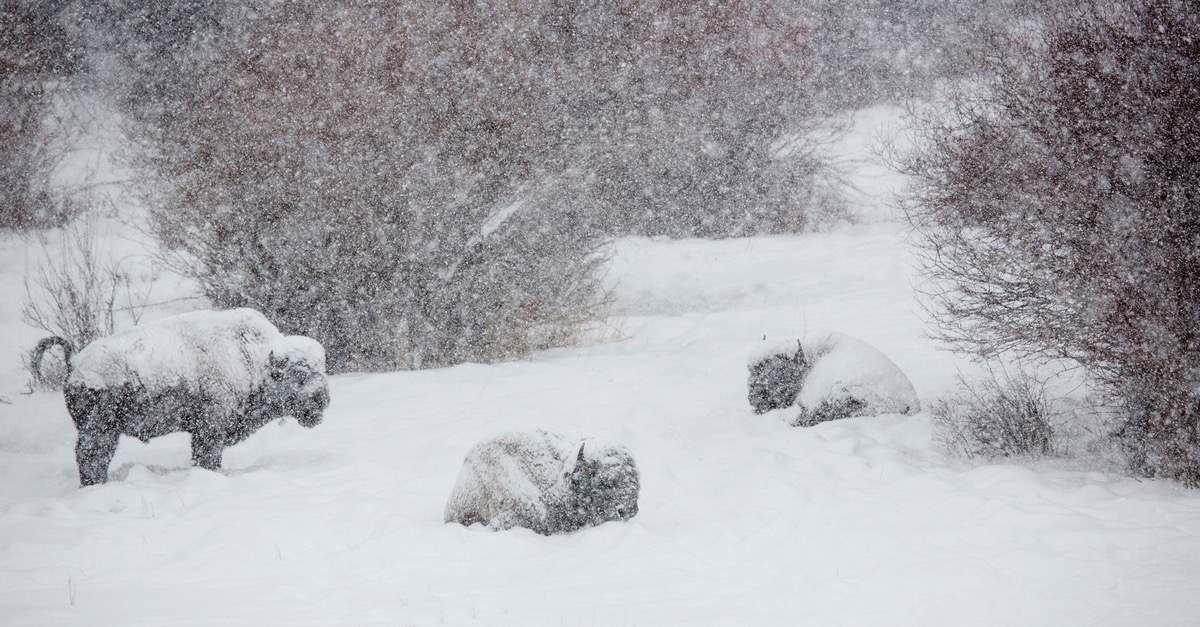
by DGR Colorado Plateau | Dec 4, 2015 | Biodiversity & Habitat Destruction
By Stephany Seay / Buffalo Field Campaign
Buffalo are still absent here in the Hebgen Basin. Patrols are conducting daily recons, searching through the buffalo’s migration corridors, but the gentle giants are keeping themselves out of Montana and, consequently, safe from the killers.
Along Yellowstone’s north boundary, in the Gardiner Basin, buffalo haven’t been so lucky. Another eight buffalo have been killed by Confederated Salish & Kootenai (CSKT) hunters who are “harvesting” ecologically extinct wild bison because they have a treaty right to do so. We would suggest that the CSKT and other tribes who hold treaty rights to the Yellowstone region also have a right to healthy, viable populations of wild bison on all federally unoccupied, unclaimed lands. And we would further suggest that the Interagency Bison Management Plan, which is driving the destruction of America’s last continuously wild buffalo herds, is not only violating the lives of wild buffalo, but violating treaty rights as well.
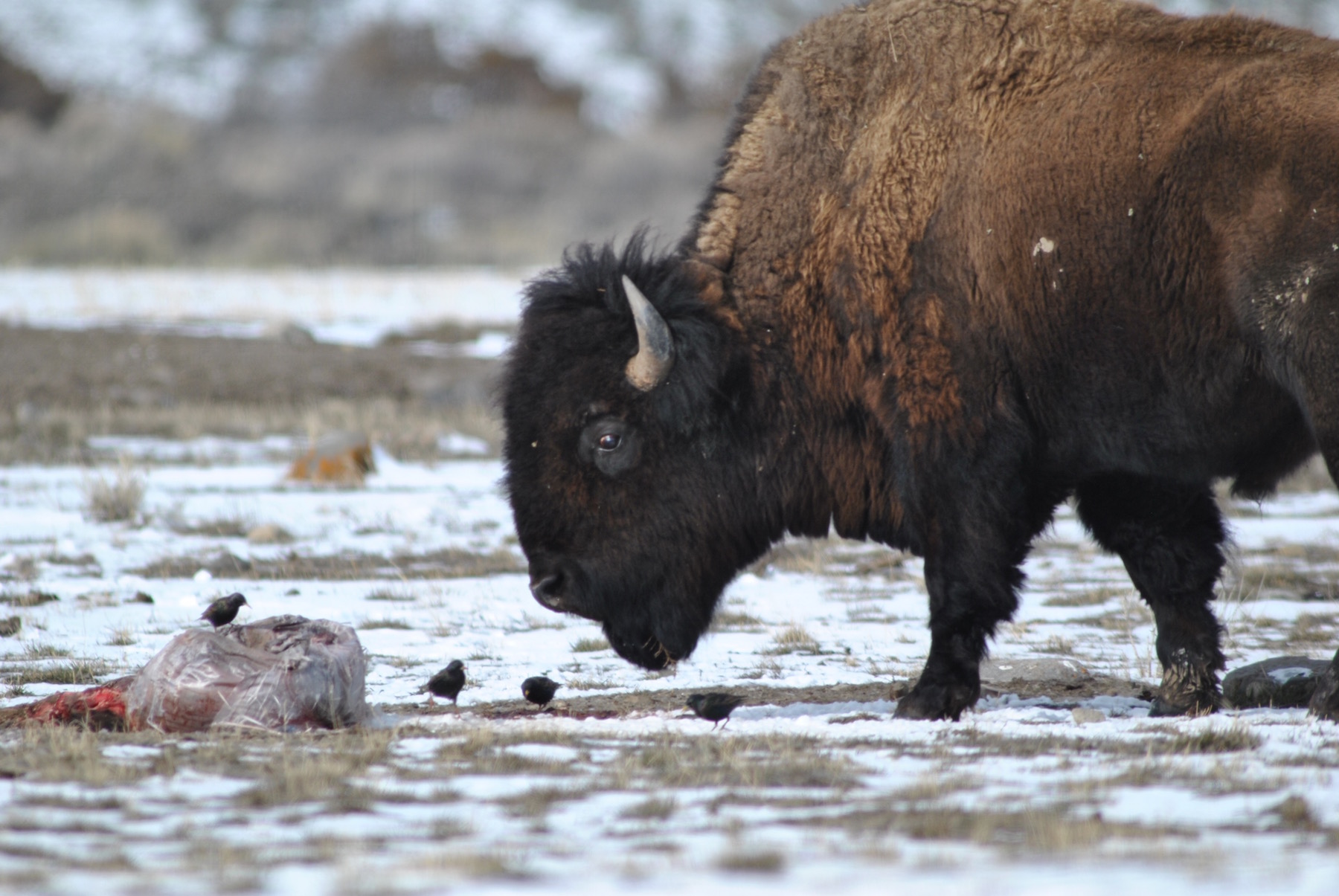
A bull bison approaches a relative’s remains, near Beattie Gulch, in the Gardiner Basin. Buffalo have intense family ties and deeply mourn the loss of those whom they love. Photo by Stephany Seay, Buffalo Field Campaign.
Most of the recent killings in Gardiner took place right outside Yellowstone’s boundary at Beattie Gulch, which is a tight bottle-neck corridor that the buffalo attempt to use to make it to other lower-elevation habitat in the Gardiner Basin. Hunters literally line up and wait for buffalo to cross the line from Yellowstone, where they can then be shot. Hunters and bison “managers” are aware that bison will seek the assumed safety of the Park when groups are shot at in this area. We have frequently seen hunters shoot into large and small groups of buffalo here, and the buffalo’s response has been to turn around and flee into the Park. This, according to Yellowstone, causes hunting to not be “effective” at killing enough, which, in turn, triggers Yellowstone’s response to initiate capture-for-slaughter operations. At the last Interagency Bison Management Plan meeting, some tribes had agreed to occasionally withhold from hunting right at the Park boundary to enable at least some buffalo to migrate to other expanses of habitat. Of course, these buffalo would still be pursued and eventually killed by hunters. The CSKT, who have killed the most through hunting this year and in years past, also hold an agreement with Yellowstone National Park to ship buffalo to slaughter. Since the CSKT also ship buffalo to slaughter, it’s not really in their interest to allow the buffalo to move further into the Gardiner Basin.
BFC’s Gardiner patrols have also reported that hunters from other tribes hunting under treaty, who normally start their seasons later in the winter going into early spring, have been arriving to Gardiner. With Yellowstone threatening slaughter, hunters are anxious to kill as many buffalo as possible before capture for slaughter begins. For the buffalo, it doesn’t matter if they cross the Park boundary or not, as they’ll likely be killed either way.
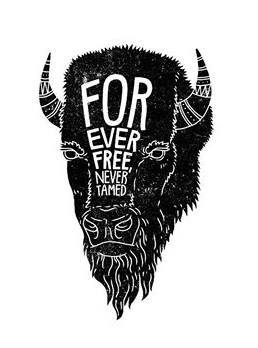
Many thanks to our friend and Gardiner resident, Fred Baker, for sharing this image with us.
The killing of the buffalo, whether it’s through “hunting” or slaughter, is all part of the Interagency Bison Management Plan (IBMP), which was crafted for the benefit of livestock interests, not buffalo. Even those hunting under treaty rights are being used by Montana’s livestock interests, and consequently, the IBMP, to facilitate the destruction of the buffalo and to prevent them from restoring themselves in Montana and elsewhere. Whether the excuse for these fatal tactics is brucellosis or population control, neither are based on reality, they only serve a political agenda. The IBMP exists because Montana livestock interests sued Yellowstone for “allowing” wild bison to migrate into Montana, and because of a law crafted by the livestock industry — MCA 81-2-120 — which places the Montana Department of Livestock in charge of managing wild bison. One industry’s intolerance is driving a national treasure towards the brink of extinction. We know you care deeply about wild bison, and one of the single most important things you can do is to help repeal this law. Contact Governor Steve Bullock today.
Wild is the Way–Roam Free!
–Stephany
Buffalo Field Campaign’s Mission: To protect the natural habitat of wild migratory buffalo and native wildlife, to stop the slaughter and harassment of America’s last wild buffalo as well as to advocate for their lasting protection, and to work with people of all Nations to honor the sacredness of wild buffalo.
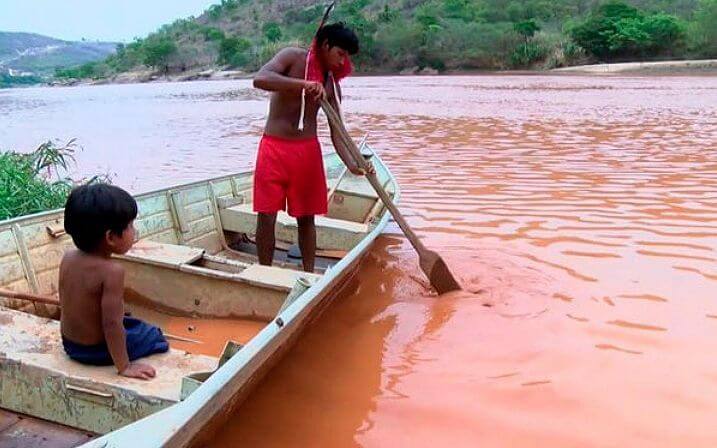
by DGR Colorado Plateau | Dec 3, 2015 | Biodiversity & Habitat Destruction, Indigenous Autonomy
by Marcela Belchior / Adital via Intercontinental Cry
What would initially appear to be the end of the line for the culture and survival of the Krenak indigenous people, impacted by the pollution of the Rio Doce, from the Mariana tragedy, in southeastern Brazil [state of Minas Gerais], could rekindle a 25 year struggle. After being left unable to live without the water of the river, the Krenak population is mobilized around a possible solution for the continuity of the community: to expand the demarcated area of the indigenous territory in the region and to migrate to a new location.
In an interview with Adital, Eduardo Cerqueira, member of the Indigenist Missionary Council (CIMI), Eastern Regional office, which comprises the states of Minas Gerais, Espírito Santo and the extreme south of Bahia, affirms that, as a way to resist the tragedy, the Krenak community [is calling] on the federal government to expand the demarcated area into 12,000 adjacent hectares, embracing the region where the State Park of Sete Salões, one of the Units of Conservation of nature belonging to the Government of Minas Gerais, is currently located.
“We find the strategy interesting, given that the existing area no longer provides conditions for survival. Something must be done”, attests Cerqueira. At present, the demarcated area of Krenak territory covers 4700 hectares. In this zone, extending more than three kilometers along the Doce River have been impacted and rendered unfit for drinking, fishing, bathing and irrigating vegetation in the vicinity, in the municipality of Resplendor, where 126 Krenak families live.
The State Park Parque de Sete Salões was created in 1998, and includes the municipalities of Conselheiro Pena, Itueta and Santa Rita do Itueto, corresponding to one of the largest remnants of Atlantic Forest in eastern Minas Gerais, with mountains, forests and waterfalls. Besides this, the area demanded has potential for indigenous community tourism, receiving visitors and marketing crafts, without damage to the environment.
The territory of the Krenak population, in Minas Gerais, was demarcated in the 1990s, but the entire length of the park was excluded, which today could once again be placed on the agenda. In the early 2000s, the Indigenous people filed a claim with the National Indian Foundation (Funai) and the federal government conducted a technical study on the matter, which to date has not been published. In the opinion of the Krenak, now, the situation is more than appropriate to fulfill the historical demand of the population.
“Various indigenous leaders are concerned about the territorial question. Now, it is a matter of necessity for this concern to be the focus of discussion. (…) This part of the region was not affected by the tailings [pollution],” defends the indigenous advocate. According to the CIMI counselor, since the socioenvironmental tragedy, the indigenous peoples affected have been assisted with emergency support, by means of tank trucks supplying water, transfer of basic food baskets and financial support for the families, which would ensure the community’s survival only in the short term.
“This tragedy was intensified by a period of severe drought. For over a year there has been no rain in the region. Because of this, the tributaries of the Rio Doce are dry. (…) The terrain is not favorable to agriculture. Livestock would be the most common form of indigenous survival, but it is not possible, without water,” explains Cerqueira.
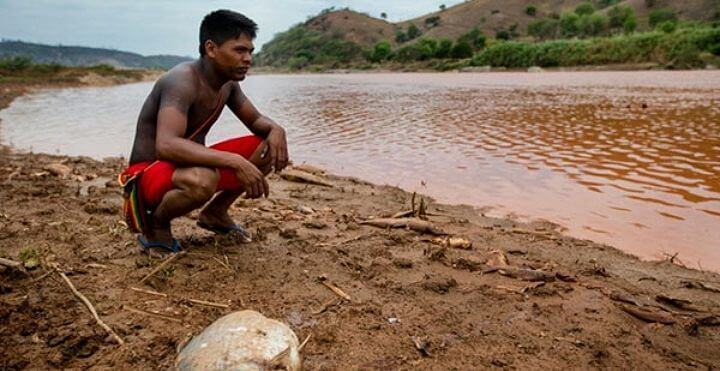
Geovani Krenak laments the death of the Rio Doce: “we are one, people and nature, only one,” he says. Photo: Reproduction.
UNDERSTANDING THE CASE
A torrent of mud composed of mining tailings (residual waste, impurities and [chemical] material used for flushing out minerals) has been flooding the 800 kilometer length of the Rio Doce since November 5, after the rupture of the Fundão dam, of the Samarco mining company. This is controlled by Vale, responsible for innumerable and grave socioenvironmental damages in Brazil, and the multinational Anglo-Australian BHP Billiton, two of the largest mining companies in the world.
In addition to burying an entire district, impacting several others and polluting the Rio Doce, extending through the states of Minas Gerais, Espírito Santo and Bahia, the mud reached the sea over the weekend, even further amplifying the environmental damage, which could take more than two decades before signs of recovery even begin to present. In addition to the destruction of fauna and flora, seven deaths and 17 disappearances have so far been recorded.
KRENAK PEOPLE CLOSE ROAD IN PROTEST
Early last week, representatives of the Krenak indigenous people, whose tribe is situated on the banks of the Rio Doce, interrupted, in protest, the Vitória-Minas Railroad. Without water for more than a week, they said they would leave only when those responsible for the tragedy talk with them. “They destroyed our lives, they razed our culture and ignore us. This we do not accept,” asserted Aiah Krenak to the press.
Considered sacred, in a culture whose cosmological worldview is based on the interconnection between all beings – humans, plants, animals, etc., the river that flows through the tribe was utilized by 350 Indians, for consumption, bathing and cleansing. “With the people, this is not separate from us, the river, trees, the creatures. We are one, people and nature, only one”, says Geovani Krenak.
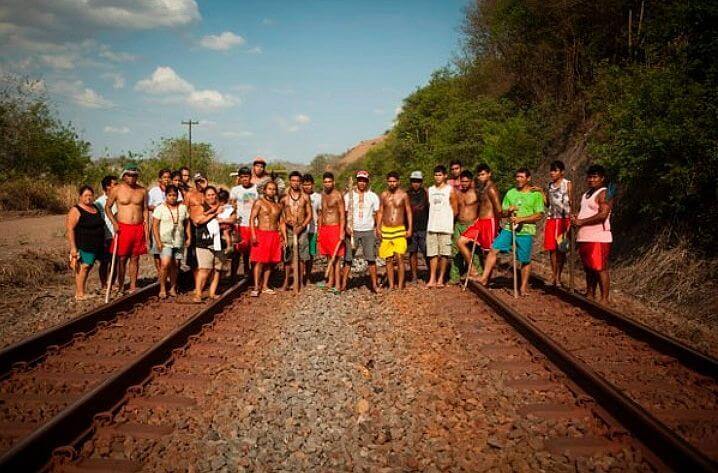
Krenak people protest on the Vitória-Minas Railroad. Photo: Reproduction.
Seated along the tracks, under a 41C. degree sun, Indians chanted music in gratitude to the river, in the Krenak language. “The river is beautiful. Thank you, God, for the river that feeds and bathes us. “The river is beautiful. Thank you, God, for our river, the river of all of us,” the words of shaman Ernani Krenak, 105 years of age, translated for the press.
His sister, Dekanira Krenak, 65 years old, is attentive to the impact of the death of the river affecting not only the indigenous peoples, being a source of resources for many communities. “It is not ‘us alone’, the whites who live on the riverbank are also in great need of this water, they coexist with this water, many fishermen [feed their] family with the fishes,” she points out.
Camped on site in tarpaulin shacks and sleeping mats in the open air, the Indians, now, must also face an unbearable swarm of insects. “It was never like this,” says Geovani Krenak. “These mosquitoes came with the polluted water, with fish that once fed us and that are now descending the river, dead, he reports.
Article originally published in Portuguese at
Adital. Translated to English for Intercontinental Cry by M.A. Kidd. Republished with permission of Intercontinental Cry.
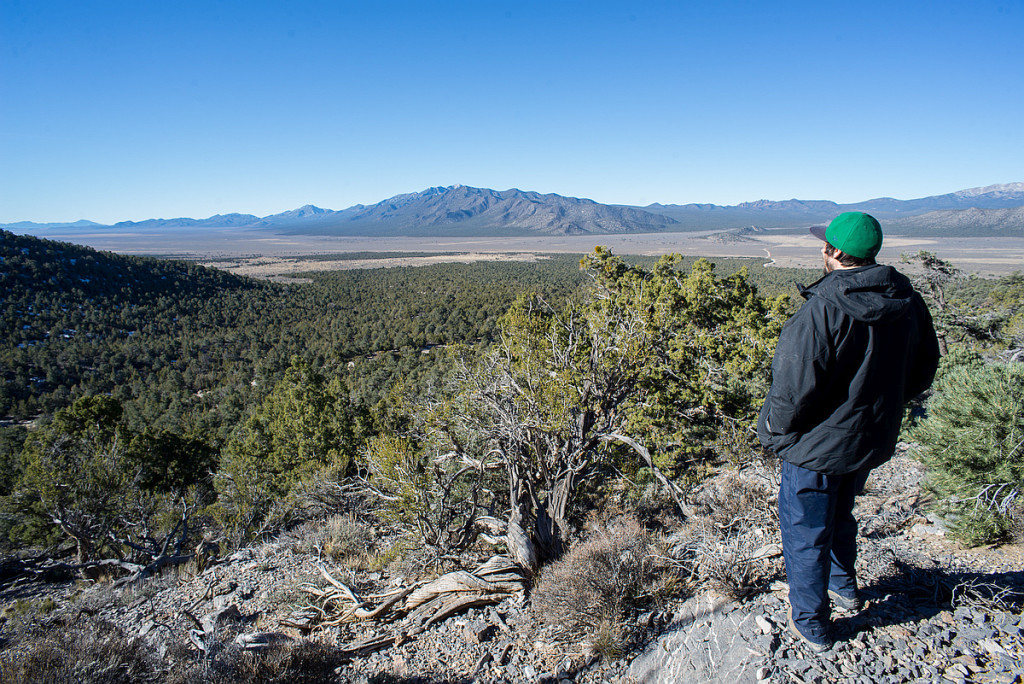
by DGR Colorado Plateau | Dec 1, 2015 | Biodiversity & Habitat Destruction, Listening to the Land, Mining & Drilling
By Will Falk / Deep Green Resistance
Standing in a pinyon-juniper forest on a high slope above Cave Valley not far from Ely, Nevada, I am lost in an ancient vision. It is a vision born under sublime skies stretching above wide, flat valleys bounded by the dramatic mountains of the Great Basin. The vision grows with the rising flames of morning in the east. The night was cold, but clear, and the sun brings a welcome warmth. When the sun crests the mountains, red and orange clouds stream across the sky while shadows pull back from the valley floor to reveal pronghorn antelope dancing through the sage brush. A few ridge lines away, the clatter of talus accompanies the movement of bighorn sheep. The slap and crack of bighorn rams clashing their heads together echoes through the valley.
As the morning passes, the sun shines through pine needles and juniper branches to dapple the forest floor in silvers and golds. The trees offer shade where patches of snow glimmer and whisper with the smallest sounds of melting. Pinyon pine cones are scattered across the ground. As they open, their seeds – delicious, nourishing pine nuts – become visible. Beautiful, blue-feathered pinyon jays gather the nuts in their beak before flying off to cache them for the deepening winter.
Humans have long participated in this vision though the vision is far older than them. From a place deeper than my mind’s memory, in the memories of the borrowed materials forming my body, I feel a kinship to this land’s original peoples. For thousands of years, in this part of the Great Basin, Shoshones and Goshutes have stood looking out at valleys like this one as they gathered the pine nuts that provided the most important winter food source making it possible for humans to live in the Great Basin’s harsh climate.
As I let my memory flow into the past, I see hundreds of generations of Shoshones and Goshutes living well off the gifts the land freely gives. Living in this way, I know their relationship with the land could have lasted forever. Pinyon pines could have gone on offering their pine nuts to jays, rats, and humans. Junipers could have gone on twisting in wooden gymnastics and growing their bundles of blue berries.
A herd of cattle catches my attention and I remember that this is just a vision, after all. The presence of cattle, here, forces me to confront the reality of the Great Basin’s ongoing destruction. An anxiety accompanies the cattle. It is the anxiety that flows from the knowledge of ecological collapse. I envy the hundreds of generations of Shoshones and Goshutes who had no reason to question the eternity of their culture.
Following the slow steps of brown and black cows, I see a metallic glint on the valley floor where streamers are tied onto fences built by ranchers so that sage grouse will not fly into the fences and kill themselves. I have seen the bundles of feathers and blood mangled and stuck in the wire fences. The cattle march to a shallow pond. A thin, but growing ring of algae floats on the pond’s surface while piles of cow shit litter sandy soil stripped of any vegetation. From the pond comes a strangled, gurgling sound. Despite the drought, water is being pumped from already strained wells to support the cattle.
The valley floor is striped in green and yellow patches. The green patches represent healthy, native sage brush and the yellow patches represent invasive crested wheat grass. I have learned how in the 1950s and 60s, the Bureau of Land Management (BLM) initiated a series of projects designed to strip away sage brush to replace it with imported Asian crested wheat grass. Not long after white settlement cattle herds wiped out most of the native grasses in the Great Basin, so now the land must be forced to support them. Destroying the sage brush has had disastrous consequences including contributing to the collapse of sage grouse populations who, as their name suggests, require healthy sage brush for habitat.
Above the valley floors, where the pinyon-juniper forests drape across the mountains’ shoulders, are brown swaths cut into the land where the forests have fallen victim to the BLM’s so-called “vegetation treatment projects.” These vegetation treatment projects are really just clear-cuts justified by the BLM as “providing woodland products to the public,” “maintaining sage brush habitat,” and “protection of property and infrastructure.”
As my experience of this ancient vision disintegrates with the reminders of the processes threatening life in the Great Basin, I remember why I came here. I came, specifically, because I had heard of the BLM’s practice of clear-cutting pinyon-juniper forests. Friends of mine asked me to write about threats to pinyon-juniper forests. I had never seen a clear-cut pinyon-juniper forest before, I knew very little about the Great Basin at all, and I’ve always thought the best way to write about the land is to seek a true relationship with it.
So, my friend, the great activist, writer, and photographer Max Wilbert flew to Salt Lake from Eugene, Oregon and we made plans to drive from my home in Park City, Utah to Nevada to see both living pinyon-juniper forests and clear-cuts. We met up with Katie Fite, a biologist and the Board Secretary for the environmental protection group, WildLands Defense. Katie brings over 30 years of on-the-ground experience to environmental advocacy possessing expertise in the Great Basin’s ecology.
***
I walk through the shades and shadows of a healthy pinyon-juniper forest. Songbirds create their music celebrating the beauty of their home. Social ravens gossip back and forth diving down to ask who I am. From time to time, I catch a grey glimpse of a rabbit bounding out of my path. The gentle hooting of an owl falls from the treetops. Though I am several hundred yards from any of my companions separated by ridge lines and hundreds of trees, I do not feel alone. A sense of deep familiarity, the feeling shared when friends gather, settles over me.
It is the 19th of November. The full cycle of seasons in the Great Basin carries the range of temperature extremes. The summers are dry and hot and the winters are frigid with plenty of snow. Even a single day in the Great Basin reflects these extremes. Last night dropped below freezing and I woke with a crisp layer of frost on my sleeping bag at dawn.
In the cold times like these, the slopes of the mountains are the warmest places to be because as the sun comes up and heats the air on the valley floor, the warm air rises. The slopes of the mountains are also where the pinyon-juniper forests are. By mid-morning, the sun is strong and hot. Even though the temperatures fell into the teens Fahrenheit last night, the temperature gains the 60s by noon. The forests, then, are the most comfortable places to be in both the cold night and the hot day. The forests are warmer at night and in the morning than the valley floors, and when the sun beats down during the day the trees offer soothing shade.
It feels, to me, that these ancient pinyon-juniper forests enjoy caring for humans.
I feel I could walk through the forest like this for miles. Then, the trees abruptly stop. The shade ceases and the sun strikes my eyes with a physical force. A cold wind, driven wild over unbroken space, slaps my face. The sudden openness is a shock. I almost trip. Behind me is a living forest, before me is a void.
I have stepped into a clear-cut.
To my left for a mile, to my right for a mile, and a quarter mile across, the land is brown. The long limbs of pinyon pines slump across the gnarled trunks of junipers. I have only seen pictures of human massacre sites. Bodies, frozen and stiff, heaped in piles. And these clear-cuts are truly tree massacre sites.
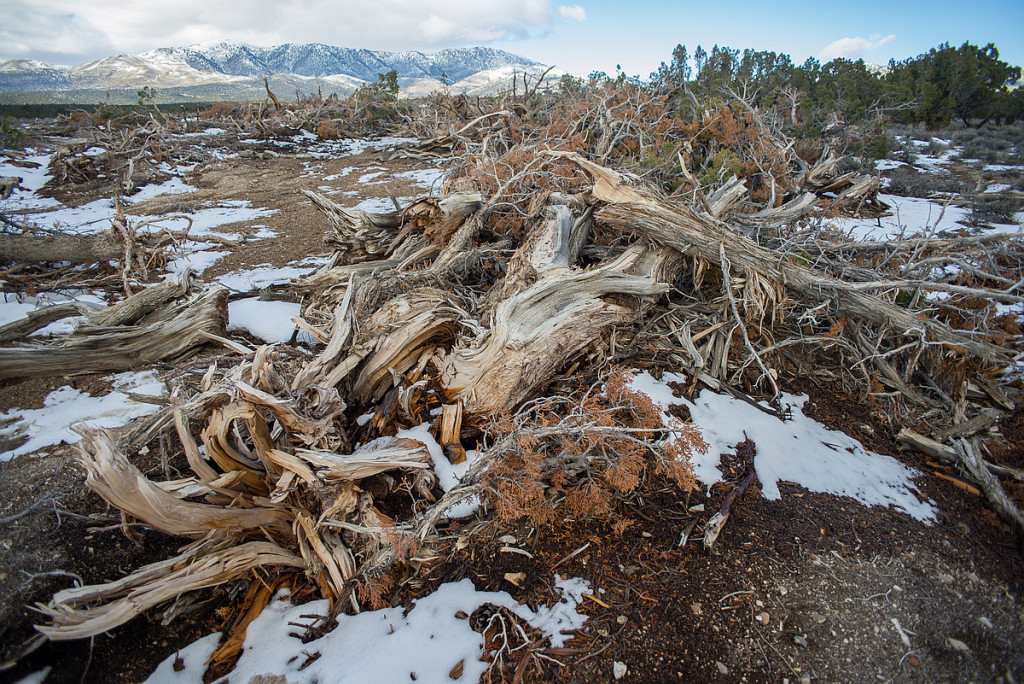
Old -growth Juniper and Piñon-Pine lie in a twisted heap in a chained area south of Spruce Mountain, Nevada. (Photo: © Max Wilbert 2015)
I can tell this particular clear-cut was “chained.” Chaining is a practice employed by the BLM and is done by stretching a U.S. Navy battle-ship anchor chain between two crawler tractors. The tractors are driven parallel to each other, dragging the chain across the forest floor, and uprooting everything in the chain’s path.
The area chosen for chaining has no logic, no reason behind it. The clear-cut follows no straight lines. The path the crawler tractors took follows no pre-conceived geometric plan. No one mapped out where trees would be cut and where they wouldn’t. The cut looks more like the devastating consequence of a petulant child’s temper tantrum than the cold-calculations of forestry professionals.
Moving through the middle of the clear-cut, now, the worst part is the silence. The silence is more than the absence of sound. This is a spiritual silence. The void seeps from the empty space where a forest once stood and flows into my consciousness. Where moments before I was surrounded in the sense of the presence of life, now there is nothing. Nothing, except the rotting corpses of a once thriving forest community.
I want to know how this is possible. I want to know what justifications cleared the way for this destruction. I want to know who is behind this. I want to know why.
***
The history of pinyon-juniper deforestation in the Great Basin as well as a list of justifications and motivations for deforestation is too long, perhaps, for one essay. The truth is, I am still learning. I have spent the last three weeks reading everything I can about pinyon-juniper forests and I wish to sketch a broad storyline. This storyline includes dominance of ranching and mining interests in Nevada, a governmental bureaucracy that consistently drinks the kool-aid prepared by ranchers and miners, the historical amnesia that characterizes settler colonialism, insidious racism, blatant genocide, and what pinyon-juniper expert Ronald Lanner calls “dendrophobia for which there seems to be no treatment.” Because one essay cannot possibly provide the whole story – a story pinyon-juniper forests desperately need to be told – I will broadly describe the major themes in this essay and I plan on writing a series on pinyon-juniper forests exploring specific themes in more detail.
The history of pinyon-juniper deforestation in the Great Basin is a glimpse into the dominant culture’s insanity. There was a truly sustainable way to live in the Great Basin, but the arrival of European settlers doomed that way of life. The Shoshones and Goshutes lived for thousands of years hunting game in the spring and summer and gathering pine-nuts in the fall. This sustainability involved understanding how to manage their populations so the land’s ability to support humans would not be drawn down. Ronald Lanner in his foundational work “The Pinyon Pine: A Natural and Cultural History,” credits pinyon pine-nuts as the essential food source that made it possible for humans to live in the Great Basin. Of course, the Great Basin’s original peoples have always known this, and know that destroying the forests is suicidal.
European settlers arrived in droves looking for precious metals and bringing their “white man’s buffalo” (domesticated cattle). Mines were established and the only reliable source of wood in most of Nevada was pinyon-juniper forests. Lanner explains, “The production of mineral riches would not have been possible in nineteenth century Nevada without the pinyon woodlands and their vast supplies of wood. The opening of a mine was only the first of many operations necessary to convert hard rock into treasure. Huge labor forces had to be brought in to work the mines and to build and operate stamp mills, smelters, amalgamators, and concentrators. Lumber in enormous quantities was needed for these operations: timbers for shoring the mine shafts, charcoal for smelting ore, cordwood for heating and cooking. The great Nevada silver boom ran on wood.”
Lanner goes on to quantify the destruction and the numbers are absolutely devastating. He explains the destruction around Eureka, Nevada in the 1870s: “A typical yield of pinyon pine was ten cords per acre, and a cord made about 30 bushels of charcoal. So the furnaces of Eureka, working at capacity, could in a single day devour over 530 cords of pinyon, the produce of over 50 acres. An additional 20 acres a day were being cut to provide cordwood for the mills. After one year of major activity, the hills around Eureka were bare for ten miles in every direction. By 1874, the wasteland extended twenty miles from town, and by 1878 the woodland was nowhere closer than fifty miles from Eureka.”
As is so often true, the destruction of the land is the destruction of the land’s original peoples. Lanner describes the situation in Nevada for the Shoshone as a “vicious circle” and writes, “The mining and urban activities there required huge amounts of wood and the burgeoning population consumed prodigious amounts of food. Local Indians helped provide both of these commodities by working for wages as lumberjacks and ranch hands. Those who cut down trees were destroying the source of their traditional winter food, pine nuts. Those who punched cattle aided and abetted the eradication of the native grasses that provided their traditional summer fare of grass seed. The more these food sources were destroyed, the more dependent the Indians became on wages; and the more they engaged in lumbering and ranching for white men, the more they destroyed their food sources. By the time the bubble burst in the 1880s and 1890s when the mining industry collapsed, the pinyon groves were gone, the valley grasslands were fenced for cattle, and much of the old culture was forsaken.”
The 1950s ushered in the next era of pinyon-juniper deforestation as ranchers became jealous of the presence of trees on potential grazing lands. Lanner notes that since the earliest white settlements in the Great Basin, accessible tracts of woodland had always been grazed. Lanner sums it up writing that overgrazing and timber trespass “combined to make the woodland one of the worst abused vegetation types in the West: even now the acre of woodland where one can find refuge from the ubiquitous cow pat is a rarity. But, as the post-World War II hunger for red meat mounted, the Forest Service started carving up National Forest woodlands with bulldozers and chains, hoping to create greener pastures.”
The ranchers’ jealousy of trees persists to today though new justifications for deforestation have been developed to thinly disguise the ranchers’ war on forests. A recent public scoping notice published on September 29, 2015 by the BLM, Carson City District, Sierra Front Field Office is illustrative.
It is not within the scope of this essay to address the problems with each of the BLM’s justifications. Many of the justifications require their own, full essay to thoroughly undermine them and I plan on writing those essays. Several of the reasons may be addressed, here, though. The BLM’s notice makes no attempt to hide ranching interests as a primary purpose for the treatments. This is clear as the BLM explains that one purpose of the vegetation treatment project is “to maintain and enhance rangeland health.” The problem with this is the Great Basin is not rangeland. The valley floors are naturally covered in sage brush and the highlands are pinyon-juniper forests. Converting the region into rangeland is only possible through great violence.
The BLM gives another justification for the deforestation with, “A large focus of this project would be to improve and protect greater sage-grouse habitat, and treatments would be designed to address threats to greater sage-grouse from invasive annual grasses, wildfires, and conifer expansion.” Of course, it was the BLM’s own disastrous policy of sage brush clearing that led to the sage grouse collapse in the first place. The BLM goes on to blame invasive annual grasses (most of which were brought to the Great Basin by settler activities), wildfires (exacerbated by human-created climate change, drought, and the planting of imported grasses that burn more quickly than native grasses), and finally to conifer expansion. By conifer expansion, the BLM is referring to pinyon-juniper forests who are simply regrowing in regions where they had been cut down by the mining operations of the 1870s.
***
I hope this essay serves as an introduction to the beauty of the Great Basin’s pinyon-juniper forests, the gifts they have long provided, and the dangers confronting them. It is time the BLM’s pinyon-juniper deforestation projects be stopped. The good news is a coalition of allied activists with Deep Green Resistance and WildLands Defense is in the early stages of planning a campaign to save these beautiful, essential, ancient forests. The first step is recognizing their inherent value as living beings. Stay-tuned for more updates including ways to get involved. Join us and stand on the side of pinyon-juniper forests.
Editor’s Note: The second installment of this multi-part series on pinyon-juniper deforestation can be found here.
Will Falk moved to the West Coast from Milwaukee, WI where he was a public defender. His first passion is poetry and his work is an effort to record the way the land is speaking. He feels the largest and most pressing issue confronting us today is the destruction of natural communities. He is currently living in Utah.
More information on this campaign can be found at Protect Piñon-Juniper Forests.

by DGR Colorado Plateau | Nov 30, 2015 | The Problem: Civilization
By Max Wilbert / Deep Green Resistance
Modern society — industrial civilization — is built on violence.
This violence goes largely unnoticed. When it is noticed, it’s often seen a series of isolated incidents, rather than a fundamental part of the dominant culture.
#
Here is an average morning inside of this culture.
First, you wake up on top of a foam mattress offgassing toxic VOCs that will not biodegrade in 10,000 years. You sit up and put on your clothes — all with tags reading “Bangladesh” and “Puerto Rico” and “Dominican Republic.” These clothes were made by virtual slaves.
You walk downstairs and fill a glass with water from the tap. The water comes from a local river that was dammed 127 years ago. Ever since, native species in the watershed have been in decline. You drink the water.
You pour yourself a bowl of cereal. The cereal is made of wheat and corn grown in what was once the tallgrass prairie of the eastern Great Plains. Ninety nine percent of that habitat – millions of acres – was plowed and utterly destroyed to grow those crops. The soil is gone now; your meal is only possible through fossil fuel fertilizers.
You add milk; it comes from a factory farm nearby, where cattle are packed in next to each other in squalor and pumped full of antibiotics and rBGH (genetically modified growth hormone) to increase production. The cows are in pain; their imprisonment is fouling the land around them. The cereal tastes good.
It’s almost time for work, so you walk down to your car. You’re somewhat environmentally conscious, so you’ve bought an electric car. It makes you feel a lot better. The car has 1000 pounds of lithium-ion batteries under the hood. The lithium for those batteries was strip-mined in the Peruvian desert; the pollution and land destroyed by the mine has devastated local people’s traditional livelihoods. You get inside the car and start the engine. It’s a push-button startup system; there is a fancy LCD screen inside. It’s modern and sleek; you pull away from the curb.
You drive on paved streets to your destination. Under those streets are indigenous burial grounds. There used to be thick old-growth forest here; now it’s a trendy, up-and-coming neighborhood. There are a few run-down houses here and there; the poor people who used to live in this neighborhood and are being forced to move, many after generations here; it’s just the latest set of refugees that have walked through this place.
You pass a police officer. The precursor of the modern police force was the slave patrol in the antebellum South. Many people live in constant fear of them.
It’s cold outside, but inside the car you’re warm and happy. You’re listening to the radio; the transmission towers are responsible for a few hundred thousand bird deaths a year. The radio is on a news station. The news person is talking about the latest bombing campaign your government is conducting. It’s taking place far away; you don’t think about it too much.
You’ve arrived at work. You work at a hospital. The hospital is on a hill. Before the concrete and buildings, there was a meadow here. It was full of flowers in the spring. Insects came from a long way away to eat from the flowers. It made the flowers happy. Many people walked through the meadow in those days. There was a good view from there. Sometimes lovers would walk there to be alone. That all changed when the settlers came with their earth-movers and road-builders.
You park your car, then walk inside. The sun is shining. It’s a nice day. You pass the gardeners working outside, spraying herbicide on the weeds. It wouldn’t do to have weeds. The gardeners have brown skin. They came from Mexico. They used to grow their own food and sell the rest in the village down the road, but after the free trade agreements opened them up to competing with Cargill, they couldn’t stay anymore. They became refugees and crossed the border. Technically, they’re in the country illegally. The land they’re on was part of Mexico before the war.
Inside the hospital, there are people waiting to be seen for appointments. They’re reading magazines. Most the magazines have pictures of women in them. The women aren’t wearing many clothes. They’re being used to sell products. A girl is reading one of the magazines. She looks about 10 years old. The leading cause of death for girls a few years older than her is eating disorders.
Another woman is hoping to have an abortion. She is only 19 years old. The hospital has Catholic roots; she won’t be allowed that level of control over her body and her future.
You walk past them, past examination rooms and surgical rooms and recovery rooms. There are receptacles everywhere for gloves, needles, and other medical waste. All the garbage from this hospital is shipped to an incinerator; it’s illegal to send it to a landfill. The incinerator is located in the middle of a poor neighborhood two states away. The smoke that comes out of its smokestack contains some of the most toxic substances known to science. There is a school a block away from the incinerator. They keep their windows closed and keep the kids inside when the smoke is rising from the facility. It doesn’t help much.
You get to your office. You touch the door as you walk in. It’s made of dense chipboard. The wood in the chipboard used to be an old-growth boreal forest. Formaldehyde and other chemical glues hold it together. Like the light switch, the computer, the examination table, the chairs, the desk, the floor tiles, and the light fixtures, the paint on the door is made from oil. The oil used in these specific light fixtures and floor tiles came from Saudi Arabia and Nigeria and Texas and Canada.
You sit down and get to work.
#
This was a very partial description of the violence in modern society. Make no mistake: this is a war.
When we are honest about the level of violence in this culture, not resisting becomes a sickening thought.
But false solutions abound; almost all of the solutions put forth to solve these problems of violence continue it in another form, or simply displace it to another area of the world or a new type of impact.
True solutions undermine the ability of industrial civilization to continue its destruction. A longtime military maxim has been that victory requires removing the ability or will of the enemy to continue their fight. This is a situation of planetary self-defense. All options are on the table, from revolutionary law-making to strategic non-violence to coordinated sabotage of industrial infrastructure.
If you’re contemplating entering the fight, remember what Andrea Dworkin famously wrote: “Resist, do not comply.”














